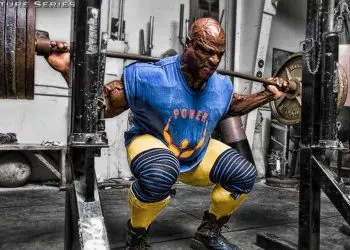Hello and welcome back to another edition of Body Mechanics. I am firm believer in training the body as one. We have covered many exercises that train the body as a whole not only for efficiency, but to develop overall strength and power. This week is no exception and we will further build on that trend. I want to add a standing barbell/dumbbell press to the mix, as last week we discussed the hang clean. The hang clean is great exercise and I hope that many of you have thought about adding it into your training regime. The reason I am going over the standing press is so that we can eventually progress into a clean and press which is a combination of what we discussed last week and what we are about to discuss today. There is a method to my madness and if you are patient with me we will get into some more challenging exercise in the weeks to come.
The standing press is predominantly a shoulder exercise and more specifically it targets the anterior deltoid, however it makes the trapezoids and triceps work
Anterior deltoid.
extremely hard in the process. The fact that it is a standing exercise increases the difficulty by forcing the core musculature including the lumbar and thoracic region of the vertebral column to stabilize the movement. Many people today will advocate the chest press as the go to upper body exercise, but they are misinformed if they overlook the importance of the standing barbell press. The shoulders play a pivotal role in the range of motion required to complete the chest press. The saying “you are only as strong as your weakest link” holds true in this case. The deltoids and the muscles within the rotator cuff are significantly smaller than the pectoral muscles. If we strengthen our smaller muscles then our bigger muscle will be able to lift greater weight. This is simply because of the smaller muscles ability to assist synergistically in the movement of the bigger muscle. What does that mean? It means a bigger bench press!
Level Up Your Fitness: Join our 💪 strong community in Fitness Volt Newsletter. Get daily inspiration, expert-backed workouts, nutrition tips, the latest in strength sports, and the support you need to reach your goals. Subscribe for free!
Lets get into the cues for the standing press, but before we do please proceed with caution as you will need to lower the weight at first in order to get it to the starting position
• Start with feet approximately shoulder width apart
• Grasp the bar in a closed pronated grip
• Grip width is slightly wider than shoulder width apart
• You can start with the weight on the ground and you can clean the bar or
• You can find an UNOCCUPIED squat rack (I hate when people do this, but safety first!) and place the bar approximately at the height of your clavicle
• Maintain a tight core
• Chest up, shoulders back, chin slightly raised, knees slightly bent
• Raise the bar to the clavicle – this is your starting position
• Extend the arms over your head until they are fully but not forcefully extended
• Lower the bar back down to the clavicle
• That completes one repetition
• Ensure that the arms are travelling in line with your ears as you raise and lower the weight
• If need be, use a push by extending at the knees when you initiate the extension of the arms to generate a force to complete the repetition
The standing press is a relatively safe exercise to complete and a more suitable exercise than the seated variation as less spinal compression is exhibited. If you have previous shoulder injuries including impingement, then I would suggest using dumbbells instead of a bar to maximize the range of motion. Remember the idea is to get better with every set, rep and breath!
Happy Lifting!





